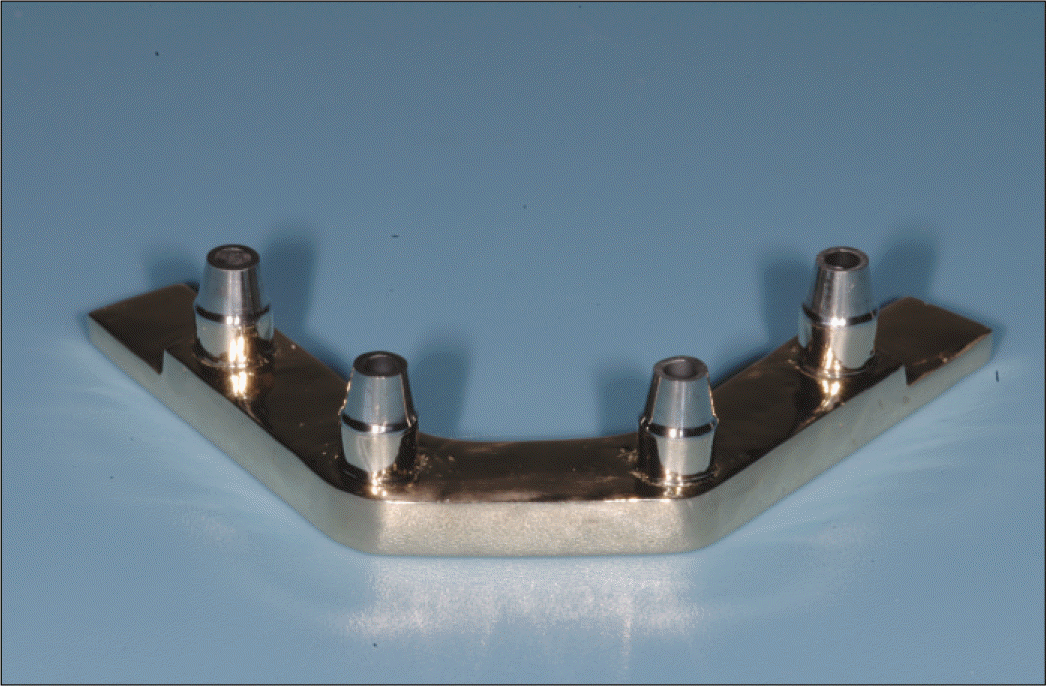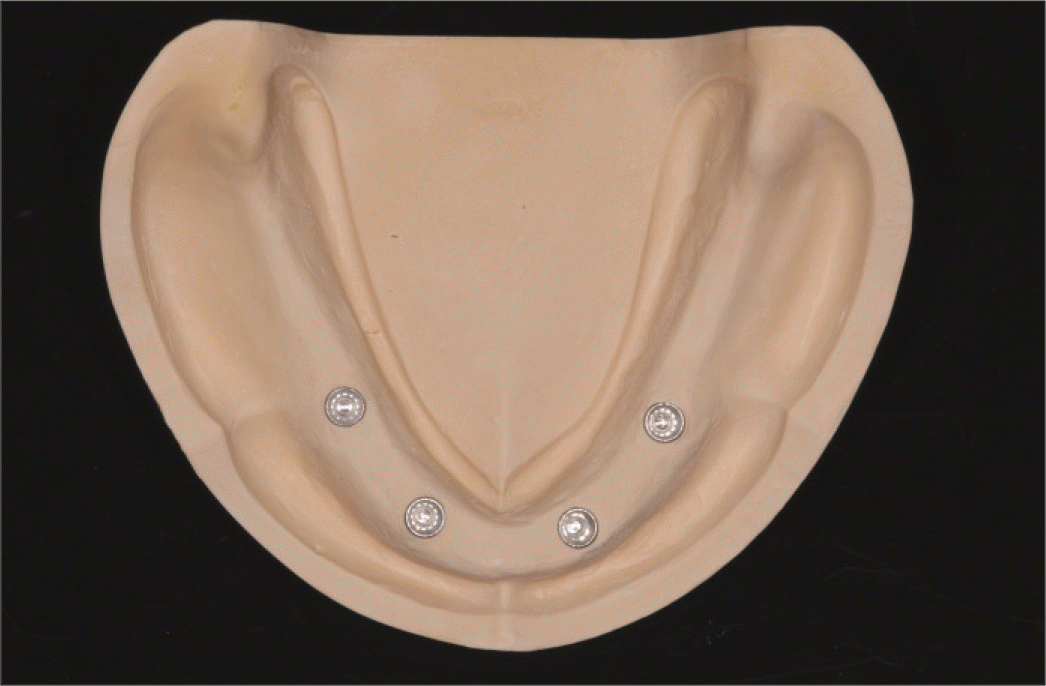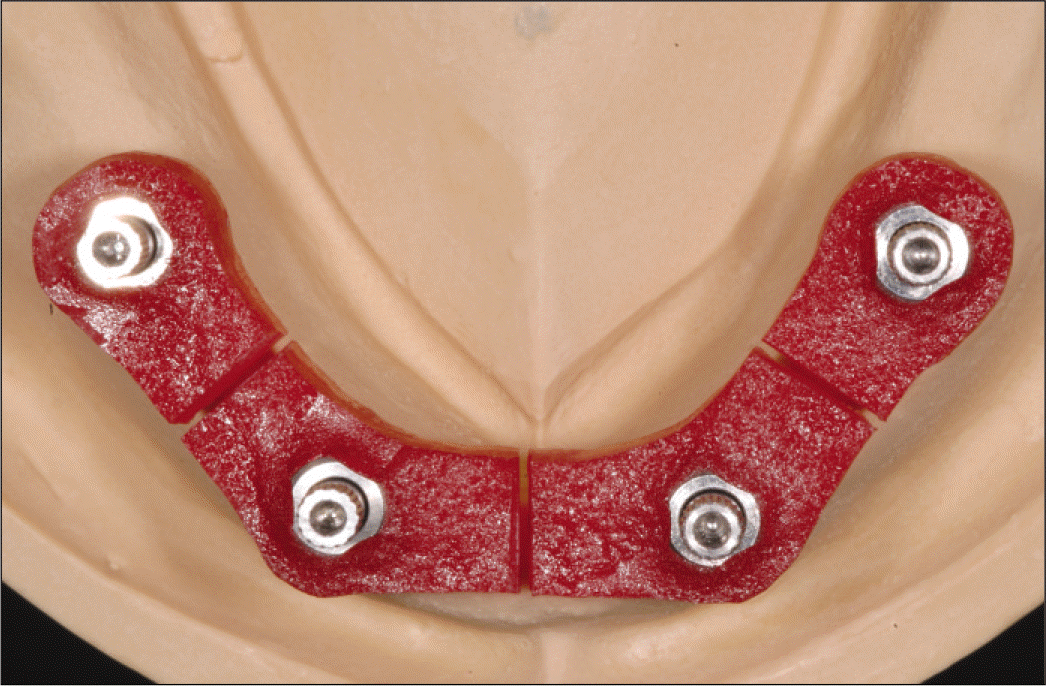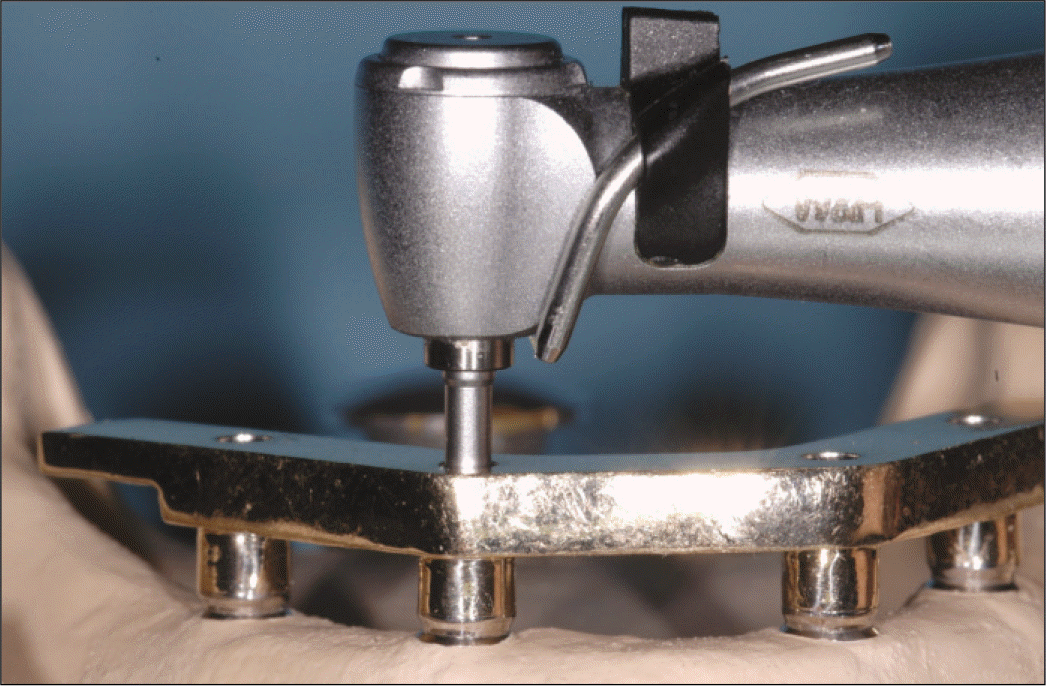Abstract
Purpose
This study evaluated the effect of different screw tightening sequences and methods on detorque values in a well-fitting implant superstructure.
Materials and methods
A fully edentulous mandibular master model and a metal framework directly connected to four parallel implants (Astra Tech) with a passive fit to each other were fabricated. Six stone casts were made with a splinted impression technique to represent a ‘well-fitting’ situation with the metal framework. Detorque values were measured twice after screw tightening using 20 Ncm. Detorque values and minimum detorque values for three screw tightening sequences (1-2-3-4, 2-4-3-1, and 2-3-1-4) and for two tightening methods (two-step and one-step) were analyzed using multi-way analysis of variance and two-way analysis of variance, respectively, at a .05 level of significance.
Results
The mean detorque values for screw tightening sequences ranged from 12.8 Ncm (2-4-3-1) to 13.1 Ncm (2-3-1-4), and for screw tightening methods were 13.1 Ncm (two-step) and 11.8 Ncm (one-step). The mean of mimimum detorque values for screw tightening sequences were 11.1 Ncm (1-2-3-4) and 11.2 Ncm (2-4-3-1 and 2-3-1-4), and for screw tightening methods were 11.2 Ncm (two-step) and 9.9 Ncm (one-step). No statistically significant differences among three screw tightening sequences were found for detorque values and for mimimum detorque values. But, statistically significant differences between two screw tightening methods were found for two values. Two-step screw tightening method showed higher detorque value (P = .0003) and higher minimum detorque value (P = .0035) than one-step method.
Conclusion
Within the limitations of this study, the screw tightening sequence was not a critical factor for the detorque values in a well-fitting implant superstructure by the splinted impression technique. But, two-step screw tightening method showed greater detorque values than one-step method. (J Korean Acad Prosthodont 2010;48:243-50)
Go to : 
REFERENCES
1.Kallus T., Bessing C. Loose gold screws frequently occur in full-arch fixed prostheses supported by osseointegrated implants after 5 years. Int J Oral Maxillofac Implants. 1994. 9:169–78.
2.Zarb GA., Schmitt A. The longitudinal clinical effectiveness of osseointegrated dental implants: the Toronto study. Part III: Problems and complications encountered. J Prosthet Dent. 1990. 64:185–94.

3.Lekholm U., van Steenberghe D., Herrmann I., Bolender C., Folmer T., Gunne J., Henry P., Higuchi K., Laney WR., Linde ′n U. Osseointegrated implants in the treatment of partially edentulous jaws: A prospective 5-year multicenter study. Int J Oral Maxillofac Implants. 1994. 9:627–35.
4.Wyatt CC., Zarb GA. Treatment outcomes of patients with implant-supported fixed partial prostheses. Int J Oral Maxillofac Implants. 1998. 13:204–11.
5.Wennerberg A., Jemt T. Complications in partially edentulous implant patients: a 5-year retrospective follow-up study of 133 patients supplied with unilateral maxillary prostheses. Clin Implant Dent Relat Res. 1999. 1:49–56.

6.Ortorp A., Jemt T. Clinical experiences of implant-supported prostheses with laser-welded titanium frameworks in the partially edentulous jaw: a 5-year follow-up study. Clin Implant Dent Relat Res. 1999. 1:84–91.
7.Hosny M., Duyck J., van Steenberghe D., Naert I. Within-subject comparison between connected and nonconnected tooth-to-implant fixed partial prostheses: up to 14-year follow-up study. Int J Prosthodont. 2000. 13:340–6.
8.Behneke A., Behneke N., d' Hoedt B. The longitudinal clinical effectiveness of ITI solid-screw implants in partially edentulous patients: a 5-year follow-up report. Int J Oral Maxillofac Implants. 2000. 15:633–45.
9.Bra ¨gger U., Aeschlimann S., Bu ¨rgin W., Ha ¨mmerle CH., Lang NP. Biological and technical complications and failures with fixed partial dentures (FPD) on implants and teeth after four to five years of function. Clin Oral Implants Res. 2001. 12:26–34.
10.Gotfredsen K., Karlsson U. A prospective 5-year study of fixed partial prostheses supported by implants with machined and TiO2-blasted surface. J Prosthodont. 2001. 10:2–7.
11.Jemt T., Henry P., Linden B., Naert I., Weber H., Wendelhag I. Implant-supported laser-welded titanium and conventional cast frameworks in the partially edentulous law: a 5-year prospective multicenter study. Int J Prosthodont. 2003. 16:415–21.
12.Andersson B., Glauser R., Maglione M., Taylor A. Ceramic implant abutments for short-span FPDs: a prospective 5-year multicenter study. Int J Prosthodont. 2003. 16:640–6.
13.Preiskel HW., Tsolka P. Cement- and screw-retained implant-supported prostheses: up to 10 years of follow-up of a new design. Int J Oral Maxillofac Implants. 2004. 19:87–91.
14.Pjetursson BE., Tan K., Lang NP., Bra ¨gger U., Egger M., Zwahlen M. A systematic review of the survival and complication rates of fixed partial dentures (FPDs) after an observation period of at least 5 years. Clin Oral Implants Res. 2004. 15:625–42.
15.Patterson EA., Johns RB. Theoretical analysis of the fatigue life of fixture screws in osseointegrated dental implants. Int J Oral Maxillofac Implants. 1992. 7:26–33.
16.Carr AB., Brunski JB., Hurley E. Effects of fabrication, finishing, and polishing procedures on preload in prostheses using conventional ‘gold'and plastic cylinders. Int J Oral Maxillofac Implants. 1996. 11:589–98.
17.Sakaguchi RL., Borgersen SE. Nonlinear finite element contact analysis of dental implant components. Int J Oral Maxillofac Implants. 1993. 8:655–61.
18.Sakaguchi RL., Borgersen SE. Nonlinear contact analysis of preload in dental implant screws. Int J Oral Maxillofac Implants. 1995. 10:295–302.
19.Haack JE., Sakaguchi RL., Sun T., Coffey JP. Elongation and preload stress in dental implant abutment screws. Int J Oral Maxillofac Implants. 1995. 10:529–36.
20.Martin WC., Woody RD., Miller BH., Miller AW. Implant abutment screw rotations and preloads for four different screw materials and surfaces. J Prosthet Dent. 2001. 86:24–32.

21.Cibirka RM., Nelson SK., Lang BR., Rueggeberg FA. Examination of the implant-abutment interface after fatigue testing. J Prosthet Dent. 2001. 85:268–75.

22.Watanabe F., Uno I., Hata Y., Neuendorff G., Kirsch A. Analysis of stress distribution in a screw-retained implant prosthesis. Int J Oral Maxillofac Implants. 2000. 15:209–18.
23.Duyck J., Van Oosterwyck H., Vander Sloten J., De Cooman M., Puers R., Naert I. Pre-load on oral implants after screw tightening fixed full prostheses: an in vivo study. J Oral Rehabil. 2001. 28:226–33.

24.Nissan J., Gross M., Shifman A., Assif D. Stress levels for well-fit-ting implant superstructures as a function of tightening force levels, tightening sequence, and different operators. J Prosthet Dent. 2001. 86:20–3.

25.Choi JH., Kim CW., Lim YJ., Kim MJ., Lee SH. The effect of screw tightening sequence and tightening method on the detorque value in implant-supported superstructure. J Korean Acad Prosthodont. 2007. 45:653–64.
26.Mojon P., Oberholzer JP., Meyer JM., Belser UC. Polymerization shrinkage of index and pattern acrylic resins. J Prosthet Dent. 1990. 64:684–8.

27.Assif D., Marshak B., Nissan J. A modified impression technique for implant-supported restoration. J Prosthet Dent. 1994. 71:589–91.

28.Pagniano RP., Scheid RC., Clowson RL., Dagefoerde RO., Zardiackas LD. Linear dimensional change of acrylic resins used in the fabrication of custom trays. J Prosthet Dent. 1982. 47:279–83.

29.Goldfogel M., Harvey WL., Winter D. Dimensional change of acrylic resin tray materials. J Prosthet Dent. 1985. 54:284–6.

30.Davis GB., Moser JB., Brinsden GI. The bonding properties of elastomer tray adhesives. J Prosthet Dent. 1976. 36:278–85.

31.Revised American Dental Association Specification no. 19 for Nonaqueous, Elastomeric Dental Impression Materials. J Am Dent Assoc. 1977. 94:733–41.
32.Hobo S., Ichida E., Garcia LT. Osseointegration and occlusal rehabilitation. Tokyo: Quintessence;1989. Chapter 9 Fully bone anchored prostheses. p. 163–86.
33.Jemt T. Failures and complications in 391 consecutively inserted fixed prostheses supported by Bra�nemark implants in edentulous jaws: a study of treatment from the time of prosthesis placement to the first annual checkup. Int J Oral Maxillofac Implants. 1991. 6:270–6.
34.Burguete RL., Johns RB., King T., Patterson EA. Tightening characteristics for screwed joints in osseointegrated dental implants. J Prosthet Dent. 1994. 71:592–9.

35.Dixon DL., Breeding LC., Sadler JP., McKay ML. Comparison of screw loosening, rotation, and deflection among three implant designs. J Prosthet Dent. 1995. 74:270–8.

36.Schulte JK., Coffey J. Comparison of screw retention of nine abutment systems: a pilot study. Implant Dent. 1997. 6:28–31.
37.Jaarda MJ., Razzoog ME., Gratton DG. Providing optimum torque to implant prostheses: a pilot study. Implant Dent. 1993. 2:50–2.
38.Kim NG., Kim YS., Kim CW., Jang KS., Lim YJ. The effect of abutment height on screw loosening in single implant-supported prostheses after dynamic cyclic loading. J Korean Acad Prosthodont. 2004. 42:664–70.
39.Norton MR. An in vitro evaluation of the strength of an internal conical interface compared to a butt joint interface in implant design. Clin Oral Implants Res. 1997. 8:290–8.

40.Merz BR., Hunenbart S., Belser UC. Mechanics of the implant-abutment connection: an 8-degree taper compared to a butt joint connection. Int J Oral Maxillofac Implants. 2000. 15:519–26.
Go to : 
 | Fig. 1.Metal framework simulating a prosthesis that directly connected to four internal-connection implants. |
 | Fig. 2.Master model with four internal-connection implant replicas made from a pickup impression of the superstructure to establish a passive fit relationship. |
 | Fig. 3.Acrylic resin splints sectioned equidistantly between the impression copings. Fifteen minutes before the impression making, these were reconnected with an incremental application technique to minimize the polymerization shrinkage of the resin. |
 | Fig. 4.Measurement of detorque values: Screw driver was carefully oriented in the long axis of the implant during screw tightening and loosening. |
Table 1.
Means and SDs of detorque values (Ncm) for screw tightening sequence & method
Table 2.
Means and SDs of detorque values (Ncm) for screw tightening sequence as a function of screw order
Table 3.
Multi-way analysis of variance for screw tightening sequence
| Source | DF | Type III SS | Mean Square | F value | P-value∗ |
|---|---|---|---|---|---|
| Reading | 1 | 6.76000000 | 6.76000000 | 1.89 | .1713 |
| Screw | 3 | 7.67475000 | 2.55825000 | 0.72 | .5441 |
| Sequence | 2 | 2.75375000 | 1.37687500 | 0.39 | .6809 |
| Order | 3 | 7.12475000 | 2.37491667 | 0.66 | .5751 |
Table 4.
Multi-way analysis of variance for screw tightening method
| Source | DF | Type III SS | Mean Square | F value | P-value∗ |
|---|---|---|---|---|---|
| Reading | 1 | 1.65375000 | 1.65375000 | 0.53 | .4673 |
| Screw | 3 | 22.02750000 | 7.34250000 | 2.37 | .0762 |
| Method | 1 | 44.55375000 | 44.55375000 | 14.36 | .0003 |
Table 5.
Means and SDs of minimum detorque values (Ncm) for screw tightening sequence & method
| N | Minimum detorque value | ||
|---|---|---|---|
| Mean | SD | ||
| Sequence | |||
| 1-2-3-4 | 12 | 11.1 | 0.84 |
| 2-4-3-1 | 12 | 11.2 | 0.93 |
| 2-3-1-4 | 12 | 11.2 | 0.77 |
| Method | |||
| Two-step | 12 | 11.2 | 0.77 |
| One-step | 12 | 9.9 | 1.19 |
Table 6.
Two-way analysis of variance for screw tightening sequence as a function of minimum detorque value
| Source | DF | Type III SS | Mean Square | F value | P-value∗ |
|---|---|---|---|---|---|
| Reading | 1 | 1.10250000 | 1.10250000 | 1.55 | .2217 |
| Sequence | 2 | 0.09500000 | 0.04750000 | 0.07 | .9354 |
Table 7.
Two-way analysis of variance for screw tightening method as a function of minimum detorque value
| Source | DF | Type III SS | Mean Square | F value | P-value∗ |
|---|---|---|---|---|---|
| Reading | 1 | 0.18375000 | 0.18375000 | 0.18 | .6797 |
| Method | 1 | 11.34375000 | 11.34375000 | 10.82 | .0035 |




 PDF
PDF ePub
ePub Citation
Citation Print
Print


 XML Download
XML Download